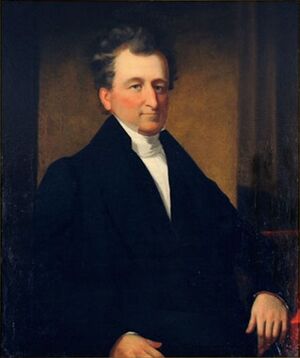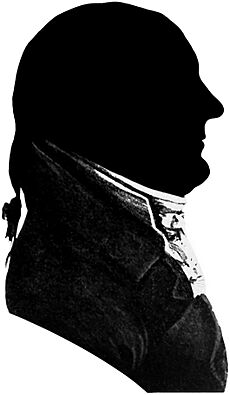John Leamy (merchant) facts for kids
John Leamy (born 1757 – died 1839) was an important merchant from Ireland who moved to America. He was a pioneer in trade between Philadelphia and the Spanish colonies in the Americas. Leamy also helped start the Insurance Company of North America and the Hibernian Society. He was a dedicated Roman Catholic and helped fund the building of St. Augustine Church.
Contents
John Leamy's Early Life
John Leamy was born in Ireland in 1757. He received his education in Spain, where he lived for several years. By 1781, he had moved to Philadelphia in the United States. He started his own business, "John Leamy and Co., Merchants," by 1785. This was noted in Philadelphia's first city directory.
How John Leamy Built His Business
Leamy became very rich by trading with Spain. This was a difficult area for most merchants. He found special ways to succeed when others would not. Later, when his unique trading position changed, he focused more on business within the United States.
Leamy's Smart Trading Methods
Spain had strict rules about trade, called mercantilism, which made it hard for foreign merchants. Leamy built strong relationships with Spanish officials. This helped him get special licenses to trade. He did favors for important Spanish figures, like delivering goods for Francisco Rendón. He also provided a house for Ambassador Josef de Jáudenes.
Leamy strengthened these connections through their shared Roman Catholicism. He also spent time with them at the City Tavern. Merchants like Leamy had to be very flexible. They would ship goods on secret routes and even pay off officials. They sometimes transported slaves to get into ports that were officially closed. After 1792, Leamy became a leader in the Spanish trade. Those who did not use his methods often failed.
Instead of competing, Leamy worked closely with New York merchants John and Thomas Stoughton. They were not official partners. However, Leamy handled their insurance, and the Stoughtons helped with his ships. They worked together to use opportunities given by Spanish officials. Leamy also used his brother, James Leamy, as his agent in Havana. This helped him avoid problems other merchants faced with unreliable contacts.
Expanding Trade and Influence
In 1788, Leamy worked with "Leamy and Elliot," but by December, he was on his own. In the late 1780s, Leamy traded with Spain, Spanish Louisiana, and the Spanish and French Caribbean. He was the first to advertise licorice in a Philadelphia newspaper. In 1789, he heavily advertised cotton from Cartagena in New Granada (now Colombia). He might have been the first American to import goods from that region.
The 1791 City Directory listed him as "Agent for His Catholic Majesty," Charles IV of Spain. It is not fully clear what this job involved. He shared secret information from Spain with the colonies. This made him act like a consul, even though he had no official diplomatic title.
By 1793, Leamy focused more on Spain and Cuba. He mainly exported flour, sending about 2,000 barrels per trip to Cuba. He returned to the United States with gold and silver coins. In 1794 alone, he brought over $100,000 worth of coins from Havana to Philadelphia. This large amount of trade sometimes caused Cuba to run low on money and food.
After trade rules were temporarily lifted, Leamy's ship John arrived in Montevideo in 1798. It carried lumber and was the first United States ship to enter the Río de la Plata. It likely returned with wool, hides, and beef.
Some of Leamy's ships were captured during the Quasi-War. This led to claims for damages against France.
To lower the risks of his business, Leamy helped create the Insurance Company of North America in 1792. He was a director and, at first, their biggest customer. Records show many of his insured ventures. He left the company in 1806 to start the Marine and Fire Insurance Company.
Challenges and Changes in Business
From 1802 to 1807, Leamy's business faced difficulties. This was when Valentín de Foronda served as Spain's consul-general in Philadelphia. Foronda was much stricter about Spanish laws than previous officials. This made Leamy's trade harder. After 1807, Leamy shifted his focus to business within the United States, especially marine insurance.
John Leamy's Community Involvement
As an Irish immigrant, Leamy was a founding member of the Hibernian Society for the Relief of Emigrants from Ireland in 1790. He served on its main committee. Two years later, he joined the Friendly Sons of St. Patrick. In the same decade, he was chosen to join the respected First City Troop. He was also considered for a special jury of merchants in a U.S. Supreme Court case in 1794.
Leamy used his wealth to become important in the Roman Catholic community. He donated $200 to build St. Augustine Church in 1796. This was the largest individual gift. Leamy also owned a pew and was once president of the board of trustees at St. Mary's. During the Hogan schism, he led a committee of trustees who supported Hogan.
John Leamy's Family Life
Records from St. Joseph's Church show Leamy had children. With Mary Doyle, he had Mary (born 1792). With his wife, Elizabeth Doughty, he had:
- Margaret (born 1794)
- John Anthony (born 1796)
- Louisa Mary (born 1798)
- Anna (born 1800)
- Elizabeth Harriet (born 1802)
A Catholic history book states that his children later became Episcopalians.
Leamy built a large home called Tusculum in Kensington. After his death, his children used it as a summer home. In 1852, Ann and Elizabeth donated the land to help start the Episcopal Hospital. The mansion was not used for patients after 1863 and was later torn down. A street near the hospital, B Street, was once called Leamy Street. Tusculum Street still exists nearby.
Death and Lasting Impact
John Leamy passed away on December 4, 1839, at 82 years old. He was buried either at St. Mary's cemetery or with his children at St. Paul's Episcopal Church. His will is kept in the Philadelphia City Archives.
Historians have noted that Leamy has not received as much attention as other merchants of his time. In 2003, Linda K. Salvucci said he was the most important American trader with the Spanish Empire of his generation. However, his importance has been overlooked by those studying Philadelphia's trade after the American Revolution. Records of his business are spread across Spain, the United States, and Cuba. This might be why he has not been studied as much.




